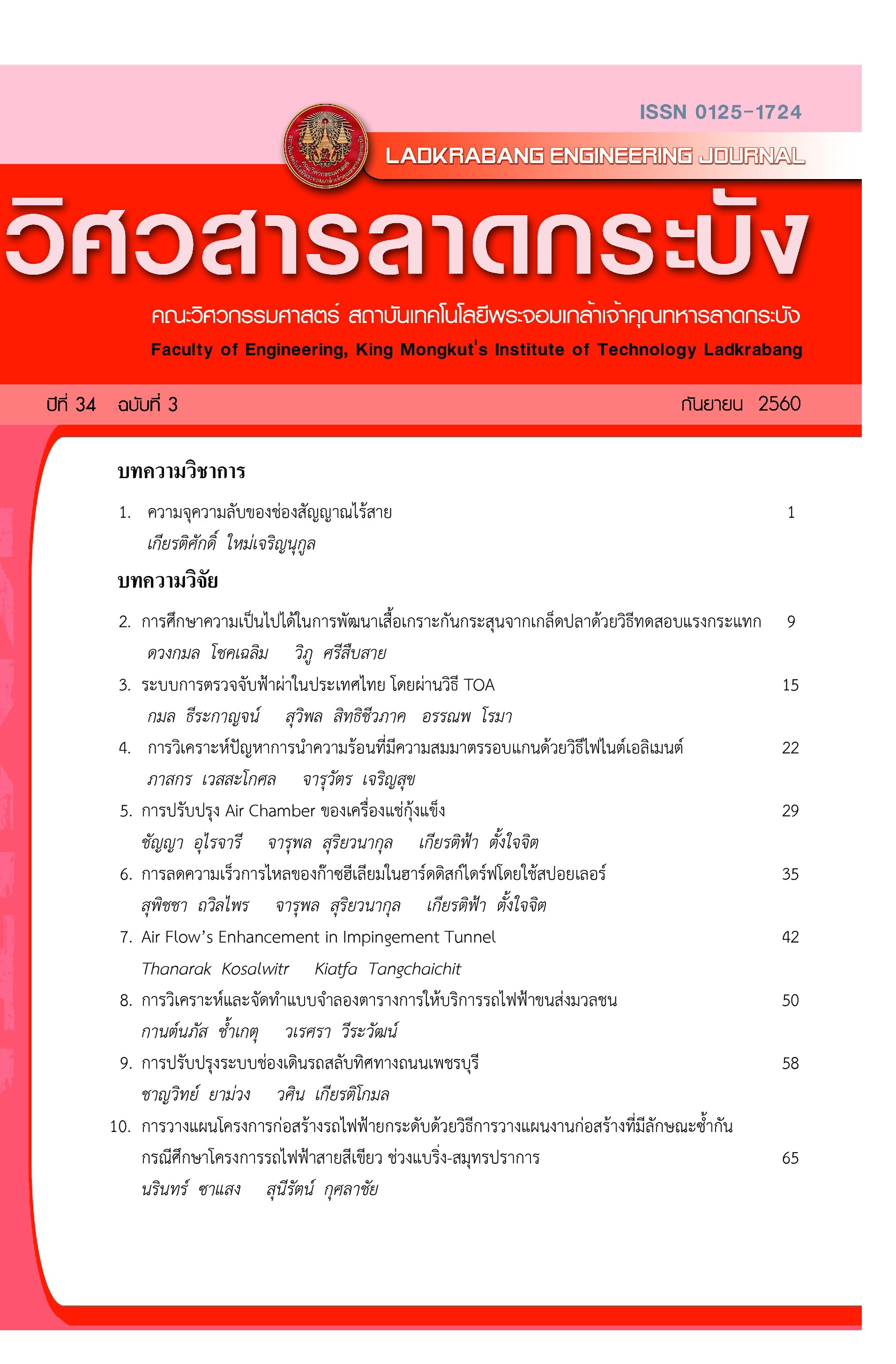Scheduling Elevated Mass Rapid Transit Project using Repetitive Construction Approach: A Case Study of MRT Green Line Project Bearing - Samutprakan Section
Keywords:
repetitive scheduling, repetitive construction, elevated mass rapid transit, MRT project, green lineAbstract
โครงการก่อสร้างรถไฟฟ้ายกระดับเป็นโครงการก่อสร้างโครงสร้างพื้นฐานขนาดใหญ่ที่มีความซับซ้อนและมักถูกวางแผนด้วยโปรแกรม Primavera และ Microsoft Project ซึ่งโปรแกรมดังกล่าวอาศัยวิธี Critical Path Method (CPM) ในการวิเคราะห์หากำหนดเวลาทำงาน เนื่องจากงานก่อสร้างโครงการรถไฟฟ้ายกระดับมีงานส่วนใหญ่ที่สามารถแบ่งงานออกเป็นหน่วยย่อยๆ โดยแต่ละหน่วยมีขั้นตอนการทำงานที่มีลักษณะซ้ำกัน (repetitive construction) และกำหนดให้แต่ละขั้นตอนมีกลุ่มคนงานและทรัพยากรเฉพาะเป็นของตนเอง (dedicated resource assignment) หลายงานวิจัยชี้ให้เห็นว่าหากใช้วิธี CPM ในการวางแผนจะทำให้การทำงานของแต่ละกลุ่มคนงานดำเนินงานไม่ต่อเนื่อง อีกทั้งก่อให้เกิดความสับสนและยุ่งยาก บทความนี้เป็นการนำเสนอขั้นตอนการวางแผนโครงการก่อสร้างรถไฟฟ้ายกระดับด้วยวิธีการวางแผนงานก่อสร้างที่มีลักษณะซ้ำกัน โดยอาศัยโครงการรถไฟฟ้าสายสีเขียว ช่วงแบริ่ง-สมุทรปราการ เป็นกรณีศึกษา เฉพาะในส่วนของงานก่อสร้างทางวิ่งยกระดับ และงานสถานี จากผลการวิเคราะห์จะเห็นได้ว่าเมื่อวางแผนงานด้วยวิธีการวางแผนงานก่อสร้างที่มีลักษณะซ้ำกัน กำหนดเวลาทำงานที่ได้ทำให้กลุ่มการทำงานในแต่ละส่วนสามารถดำเนินงานได้อย่างต่อเนื่อง รองรับเงื่อนไขการทำงานทางเทคนิคภายใต้กรอบกำหนดเวลาตามสัญญา และมีรูปแบบการนำเสนอที่ค่อนข้างกระชับ พร้อมกันนี้ยังสามารถระบุระยะเวลาลอยตัวหรือระยะเวลาเผื่อเพื่อรองรับความเสี่ยงที่อาจเกิดขึ้น นอกจากนี้งานวิจัยยังชี้ให้เห็นว่ารูปแบบการนำเสนอของการวางแผนงานก่อสร้างที่มีลักษณะซ้ำกันทำให้ผู้วางแผนเห็นถึงทางเลือกการใช้ทรัพยากรเพื่อให้แผนงานมีประสิทธิภาพ
References
[2] D. Arditi, B. O. Tokdemir and K. Suh, “Challenges in Line-of-Balance Scheduling,” Journal of Construction Engineering and Management, Vol.128, No.6, pp.545-556, 2002.
[3] K. El-Rayes, and O. Moselhi, “Resource-driven scheduling of repetitive activities,” Construction Manage and Economics, Vol.16, No.4, pp.433-446, 1998.
[4] I-Tung Yang and P. G. Ioannou, “Resource-driven scheduling for repetitive project: a pull–system approach,” The 9th International Group for Lean Construction Conference, National University of Singapore, 6-8 August 2001.
[5] E. N. Chrzanowski and D. W. Johnson, “ Application of Linear Scheduling,” Journal of Construction Engineering and Management, Vol.112, No.4, pp.476-491, 1988.
[6] D. J. Harmelink and J. E. Rowing, “Linear Scheduling Model: Development of Controlling Activity Path,” Journal of Construction Engineering and Management, Vol.124, No.4, pp.263-268, 1998.
[7] A. Yamin and D. Harmelink , “Comparison of Linear Scheduling Model (LSM) and Critical Path Method (CPM),” Journal of Construction Engineering and Management, Vol.127, No.5, pp.374-381, 2001.
Downloads
Published
How to Cite
Issue
Section
License
The published articles are copyrighted by the School of Engineering, King Mongkut's Institute of Technology Ladkrabang.
The statements contained in each article in this academic journal are the personal opinions of each author and are not related to King Mongkut's Institute of Technology Ladkrabang and other faculty members in the institute.
Responsibility for all elements of each article belongs to each author; If there are any mistakes, each author is solely responsible for his own articles.






